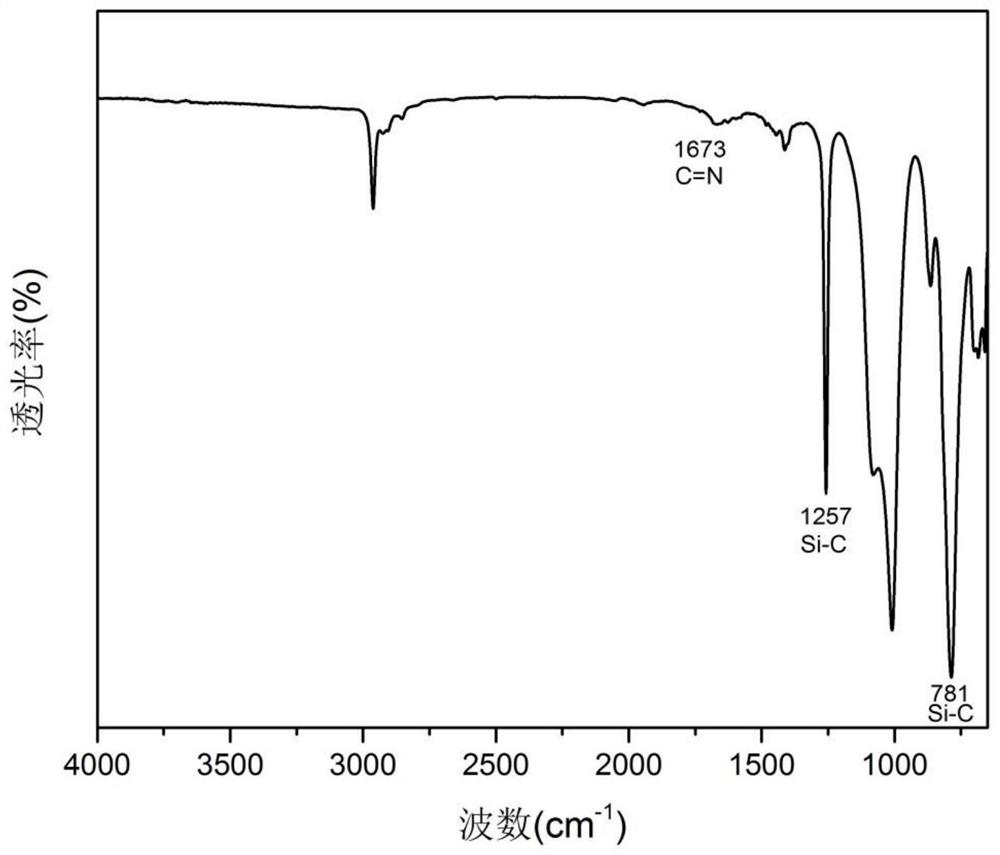Application of polysiloxane elastomers based on aryl disulfide bonds and imine bonds as self-healing materials
The technology of polysiloxane and healing material is applied in the field of polysiloxane elastomer and its preparation, which can solve the problems of difficult implementation, stimulation, harsh conditions, etc., and achieve the effects of low cost, simple synthesis process and obvious application prospect.
- Summary
- Abstract
- Description
- Claims
- Application Information
AI Technical Summary
Problems solved by technology
Method used
Image
Examples
Embodiment 1
[0031] (1) Empty 50ml of the reaction bottle, the extraction - the inflation process three times to exclude oxygen in the system. 5 g of polydimethylsiloxane and 0.248 g of 4,4'-diaminobenzothybenzozine were placed in the reaction bottle, and then charged once. 20 ml of anhydrous methylene chloride was injected, and stirred thoroughly to completely dissolve.
[0032] (2) Empty 50ml of the reaction bottle, the extraction - the inflation process three times to exclude oxygen in the system. 0.162 g of 1,3,5-triphenylhydehyde, 0.015 g of trifluoromethanesulfonate is placed in the reaction bottle, and then charge it once. 10 ml of anhydrous methylene chloride was injected, and stirred thoroughly to completely dissolve.
[0033] (3) In the solution of the needle tube extraction step (1), in the solution of step (2), at room temperature for 24 h, the reaction solution poured into the mold of Tufluoroethylene, and the mold was placed in a fan in a fume hood. Overnight, dried in a vacuum o...
Embodiment 2
[0035] (1) Empty 50ml of the reaction bottle, the extraction - the inflation process three times to exclude oxygen in the system. 5 g of polydimethylsiloxane and 0.062 g of 4,4'-di aminoxylbenzozine were placed in the reaction bottle, and then charged once. 20 ml of anhydrous methylene chloride was injected, and stirred thoroughly to completely dissolve.
[0036](2) Empty 50ml of the reaction bottle, the extraction - the inflation process three times to exclude oxygen in the system. 0.081 g of 1,3,5-triphenylhydraldehyde, 0.011 g of trifluoromethanesulfonate is placed in the reaction bottle, and then charge it once. 10 ml of anhydrous methylene chloride was injected, and stirred thoroughly to completely dissolve.
[0037] (3) In the solution of the needle tube extraction step (1), in the solution of step (2), at room temperature for 24 h, the reaction solution poured into the mold of Tufluoroethylene, and the mold was placed in a fan in a fume hood. Overnight, dried in a vacuum ov...
Embodiment 3
[0039] (1) Empty 50ml of the reaction bottle, the extraction - the inflation process three times to exclude oxygen in the system. 5 g of polydimethylsiloxane and 0.248 g of 4,4'-diaminobenzothybenzozine were placed in the reaction bottle, and then charged once. 20 ml of anhydrous methylene chloride was injected, and stirred thoroughly to completely dissolve.
[0040] (2) Empty 50ml of the reaction bottle, the extraction - the inflation process three times to exclude oxygen in the system. 0.162 g of 1,3,5-trimethylhydrahydehyde, 0.025 g of trifluoromethanesulfonate is placed in the reaction bottle, and then charge it once. 10 ml of anhydrous methylene chloride was injected, and stirred thoroughly to completely dissolve.
[0041] (3) In the solution of the step (2), the solution in the step (2) was added to the solution of the step (2), and the reaction solution was poured into the mold of Tufluoride, and the mold was volatilized in a fan in a fan. Overnight, dried in a vacuum oven ...
PUM
| Property | Measurement | Unit |
|---|---|---|
| elongation at break | aaaaa | aaaaa |
Abstract
Description
Claims
Application Information
 Login to View More
Login to View More - R&D
- Intellectual Property
- Life Sciences
- Materials
- Tech Scout
- Unparalleled Data Quality
- Higher Quality Content
- 60% Fewer Hallucinations
Browse by: Latest US Patents, China's latest patents, Technical Efficacy Thesaurus, Application Domain, Technology Topic, Popular Technical Reports.
© 2025 PatSnap. All rights reserved.Legal|Privacy policy|Modern Slavery Act Transparency Statement|Sitemap|About US| Contact US: help@patsnap.com



